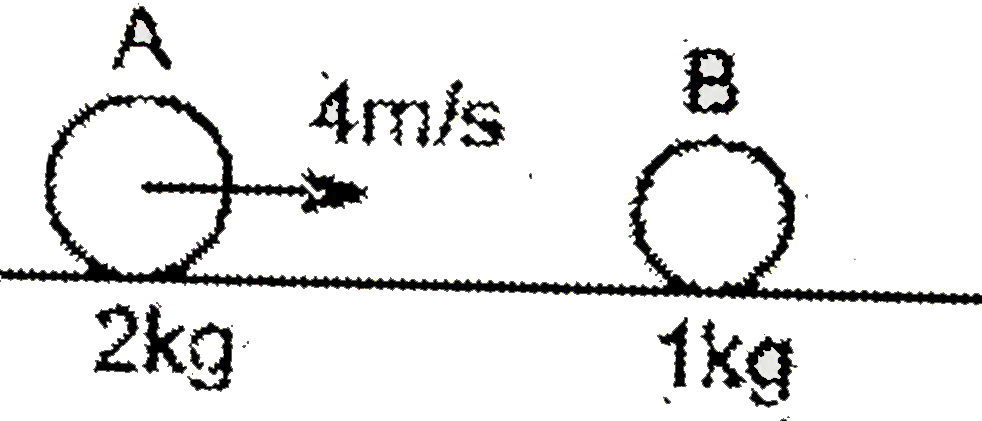Complete Solutions to L-3,(P-1) of chapter IMPULSE AND MOMENTUM of Class 11 book with complete answers and questions
| Class 11 | PHYSICS |
| Chapter | IMPULSE AND MOMENTUM |
| ANURAG MISHRA | L-3,(P-1) |
| Number Of Questions | 5 |
| Academic Year | 2023-24 |
While dealing with collision between particles, you must have deal from and Inertial reference frame Often we choose that frame to be fixed in the Laboratary in which the collision is observed. So it is called the Laboratary reference frame or Lab frame From Lab frame we define an elastic collision as a collision in which KE before and after collision is conserved and a perfectly inelastic collision as a collision in which after collision the two colliding bodies have same velocity vector along the line of action of impulse during collision.
If we discusss the head-on collsion between two particles from center of mass reference frame, then the velocity of center of mass (CM) will be taken to be zero in any type of collision i.e. velocity of CM before and after collision will both be zero. Since before collsion velocity of CM was zero (as our frame is fixed to CM) and no external impulse acts, it will remain zero forever
From CM frame, after a head-on elastic collision:
View SolutionWhile dealing with collision between particles, you must have deal from and Inertial reference frame Often we choose that frame to be fixed in the Laboratary in which the collision is observed. So it is called the Laboratary reference frame or Lab frame From Lab frame we define an elastic collision as a collision in which KE before and after collision is conserved and a perfectly inelastic collision as a collision in which after collision the two colliding bodies have same velocity vector along the line of action of impulse during collision.
If we discusss the head-on collsion between two particles from center of mass reference frame, then the velocity of center of mass (CM) will be taken to be zero in any type of collision i.e. velocity of CM before and after collision will both be zero. Since before collsion velocity of CM was zero (as our frame is fixed to CM) and no external impulse acts, it will remain zero forever
From CM frame, after a perfectly inelastic head-on collision:
View SolutionWhile dealing with collision between particles, you must have deal from and Inertial reference frame Often we choose that frame to be fixed in the Laboratary in which the collision is observed. So it is called the Laboratary reference frame or Lab frame From Lab frame we define an elastic collision as a collision in which KE before and after collision is conserved and a perfectly inelastic collision as a collision in which after collision the two colliding bodies have same velocity vector along the line of action of impulse during collision.
If we discusss the head-on collsion between two particles from center of mass reference frame, then the velocity of center of mass (CM) will be taken to be zero in any type of collision i.e. velocity of CM before and after collision will both be zero. Since before collsion velocity of CM was zero (as our frame is fixed to CM) and no external impulse acts, it will remain zero forever
Two particles of mass 2 kg and 1kg as shown in the figure make a perfectly inelastic collision. Then if we are dealing with center of mass reference frame, the velocity of B before collision is:

View SolutionWhile dealing with collision between particles, you must have deal from and Inertial reference frame Often we choose that frame to be fixed in the Laboratary in which the collision is observed. So it is called the Laboratary reference frame or Lab frame From Lab frame we define an elastic collision as a collision in which KE before and after collision is conserved and a perfectly inelastic collision as a collision in which after collision the two colliding bodies have same velocity vector along the line of action of impulse during collision.
If we discusss the head-on collsion between two particles from center of mass reference frame, then the velocity of center of mass (CM) will be taken to be zero in any type of collision i.e. velocity of CM before and after collision will both be zero. Since before collsion velocity of CM was zero (as our frame is fixed to CM) and no external impulse acts, it will remain zero forever
After collision, the velocity of B in CM reference frame will be
View SolutionWhile dealing with collision between particles, you must have deal from and Inertial reference frame Often we choose that frame to be fixed in the Laboratary in which the collision is observed. So it is called the Laboratary reference frame or Lab frame From Lab frame we define an elastic collision as a collision in which KE before and after collision is conserved and a perfectly inelastic collision as a collision in which after collision the two colliding bodies have same velocity vector along the line of action of impulse during collision.
If we discusss the head-on collsion between two particles from center of mass reference frame, then the velocity of center of mass (CM) will be taken to be zero in any type of collision i.e. velocity of CM before and after collision will both be zero. Since before collsion velocity of CM was zero (as our frame is fixed to CM) and no external impulse acts, it will remain zero forever
If collision were elastic in above question then velocity of B after collision in CM reference frame will be:
View Solution
L-3,(P-1) questions and complete solutions for chapter IMPULSE AND MOMENTUM of SHREE BALAJI PHYSICS (HINGLISH) of Class 11